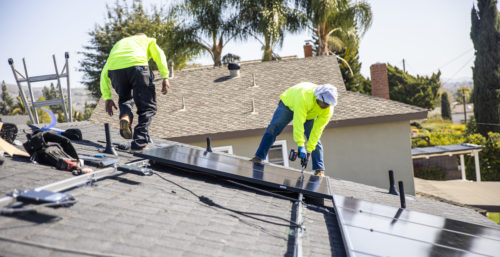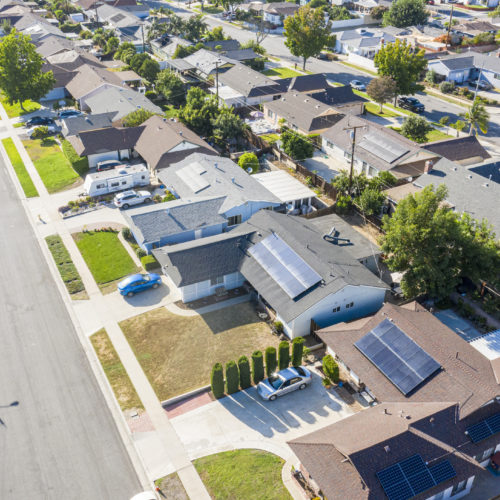A team of workers installing solar panels on a home in Southern California

Getting More Solar on Rooftops Across the Country
A New Program to Streamline the Solar Permitting Process Can Be a Game Changer
To meet the US goal of decarbonizing the power sector by 2035, we need to rapidly green the grid. A large part of that means installing more solar PV systems on rooftops across the country. Unfortunately, we are still in the dark ages when it comes to the permitting process for residential solar. Cities around the country are facing backlogs due to red tape, paper applications, and inefficient permitting processes. But a new program, SolarAPP+, can greatly reduce the time to permit solar installations, cutting costs for cities, installers, and customers.
Bringing Solar Permitting into the 21st Century
In the United States, solar permitting is spread across more than 23,000 separate jurisdictions and 3,000 utilities. This makes for a fragmented and unstandardized process, leading to long waits for permits. In some places homeowners wait for months to get their systems on line. In fact, last year, solar project delays cost homeowners $16 million in wasted energy. The drawn-out permitting process also causes many customers to actually cancel their installations.
“There is extraordinary untapped potential for residential solar to advance climate and community resilience solutions in the United States. But we’re held back by unstandardized, slow, expensive permitting processes that make solar installation far more difficult than it needs to be,” says Rushad Nanavatty, managing director for RMI’s Urban Transformation Program.
A new online permitting application, SolarAPP+, developed by the National Renewable Energy Laboratory, RMI, solar industry leaders, and local governments, is setting out to change that. SolarAPP+ is a universal web-based program that any local government can use, for free, to instantly process and evaluate permitting applications. The program reviews applications as soon as the solar installer submits them online, and then issues a permit after the fee is paid. This can cut the average permit processing time from five working days to less than an hour.
So far, four jurisdictions have been using SolarAPP+ in a pilot project: Tucson, Arizona; Pima County, Arizona; Menifee, California; and Pleasant Hill, California. All of them have had great success. “The permitting process was taking four weeks,” says Tucson Mayor Regina Romero. “Now we give the permit the same day… We just approved about 450 installations in the last 60 days alone using SolarAPP+.”
According to RMI SolarAPP+ Coordinator Arthur Coulston, “Industry has made significant progress improving their processes and lowering costs. But permitting has not seen the same improvement—and due to the growing volume of permit applications, it is even getting worse in some places. This is a critical challenge that neither industry nor government can solve on their own. RMI has played an important role in bringing these stakeholders together to ensure the success of SolarAPP+.”
Houston, which has one of the highest levels of per capita greenhouse gas emissions in the country, also has one of the country’s most ambitious climate action plans. The plan includes a goal of generating 5 million MWh from local rooftop and community solar projects per year by 2050. “Simplifying and streamlining the solar permitting process is one of the few levers the City of Houston has to reduce barriers to adoption,” according to Houston Mayor Sylvester Turner. “Automating plan review, permit approval, and project tracking would also save time and money for both installers and the City. This is why I have asked the permitting center to test the SolarAPP+ software in Houston,” Turner adds.
A Win for the Climate
Currently only about 3 percent of US single-family homes have rooftop solar, a total of about 3 GW. “If we want to take the least-cost pathway to power system decarbonization, we have to employ more distributed renewables,” says Nanavatty. “Specifically, the latest robust analysis suggests we need to install close to 250 gigawatts of rooftop solar capacity in the system.”
One of the best ways to do this is to make solar installations easier and cheaper. Residential solar costs an average of $3.30/watt in the United States, more than twice as much as in other leading solar countries. In Australia, the cost is only $1.10/watt, and 29 percent of Australian homes have rooftop solar. The lower cost is in large part due to a streamlined permitting and interconnection process.
“A lot of times people look at the home and the rooftop as a small solution, but it’s one of the fastest ways we can get more solar on the grid,” says Lynn Jurich, CEO of solar installation company SunRun. “People think a renewable future has to be a sacrifice. This is a better future. [SolarAPP+] will help us build out the distributed system. We have these tools to solve the climate crisis right now,” she adds.
Increasing Resilience
The + in SolarAPP+ refers to battery storage, which is also part of the SolarAPP+ program. More rooftop solar, with the addition of battery storage, will greatly increase resilience. Last year’s record wildfire season burned over 4 million acres, and utilities in California shut off power to tens of thousands of residents. If these families had solar plus storage, they could have kept the lights on, the refrigerators running, and life-saving medical equipment powered.
Some jurisdictions report that they are receiving more permit applications for solar and battery storage than for any other building category. In fact, the cumulative capacity of home solar and storage is projected to grow by more than twofold and eighteenfold, respectively, by 2025. Streamlining the permitting process for these applications can help get resilient solar-plus-battery systems in homes across the country.
Creating Jobs
SolarAPP+ can also help grow jobs. The residential rooftop solar industry is a major job producer. In 2019, residential solar represented over 90,000 of the 160,000 installation and project development solar jobs in the United States (out of 250,000 total solar jobs), representing growth of 269 percent since 2010. Of those jobs, 93 percent are with small businesses that employ fewer than 250 people.
To date, installers have entirely avoided some jurisdictions with onerous permitting. This reinforces the unequal distribution of the solar industry effort; only five states account for two-thirds of all cumulative residential solar installations. By reducing the cost of rooftop solar, automated online permitting could further increase demand and the business activity and jobs that come with it.
Improving Equity
Although the cost of solar has fallen drastically in the past decade, rooftop solar is still inaccessible to many Americans. Widespread adoption of SolarAPP+ has the potential to cut the cost of a residential solar PV system by up to $1,500, making solar accessible to many more Americans.
According to Mayor Romero, SolarAPP+ has allowed Tucson to charge less for the permit. “It becomes less expensive for the installation, making solar more available to low-income communities in the city. It helps not just the companies install much more, it helps low-income families and helps with the city’s climate goals,” she says.
Stockton, California, has a project to work in at-risk neighborhoods to alleviate the effects of climate change. One of the city’s goals is to install rooftop solar for free on 108 single-family homes and four multifamily dwellings. “To have SolarAPP+ before we go through that process will help us meet those project goals,” says City Manager John Alita.
Helping to Deploy, Deploy, Deploy
To reach our climate goals, “we’re going to need to deploy, deploy, deploy clean energy technologies,” according to US Secretary of Energy Jennifer Granholm. “We have no time to waste, as we are seeing the record-breaking heat waves and droughts and wildfires that are ravaging parts of the country. This tells us that the costs of delays are too high. And at the same time the economics tell us that there is simply no reason to wait, because solar power just makes sense.”
The United States has a goal of cutting the price of solar in half in the next decade and making it the cheapest source of electricity in America. Lowering the costs by streamlining the permitting process is a large part of that. SolarAPP+ is a free, valuable, and effective tool to help us get there.

